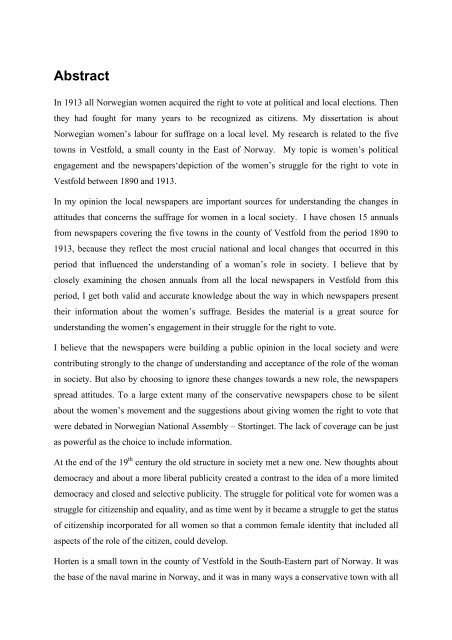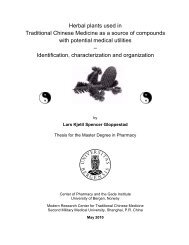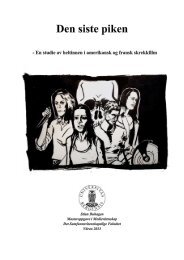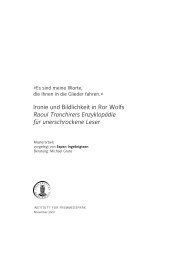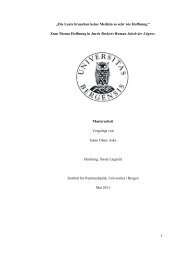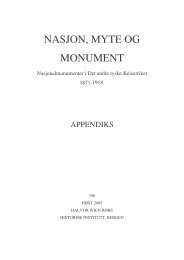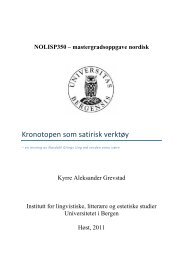- Page 1 and 2: Kvinnestemmeretten i Horten og de a
- Page 3: Forord Dette er et punktum for en p
- Page 7: The Suffrage Clubs clearly wanted t
- Page 10 and 11: 3. 3. 2. Lokalpressen og kvinnestem
- Page 12 and 13: 1. 1. 2. Avgrensning av perioden Je
- Page 14 and 15: hadde delt sin felles utenforståen
- Page 16 and 17: Gunnela Bjørk peker på at aviser
- Page 18 and 19: På slutten av 1800-tallet hadde vi
- Page 20 and 21: Thorbjørn Wale undersøker samspil
- Page 22 and 23: Josefin Rönnbäck kaller argumenta
- Page 24 and 25: ettferdighetskrav. Da borgerkrigen
- Page 26 and 27: Bertil Bjørkenlid hevder at suffra
- Page 28 and 29: Et annet virkemiddel i kampen for s
- Page 30 and 31: paragrafen skulle lyde:"Stemmeberet
- Page 32 and 33: varmt for kvinnestemmretten. I 1909
- Page 34 and 35: Selv om Venstre ut fra sitt liberal
- Page 36 and 37: eldorado for tjenestepiker, her var
- Page 38 and 39: Det ble også debattert hvor store
- Page 40 and 41: Hvor mye kontakt hadde det lokale k
- Page 42 and 43: innleggene og styre debatten så le
- Page 44 and 45: Også Ida Blom tillegger splittelse
- Page 46 and 47: Kvinnene i Diskusjonsforeningen ten
- Page 48 and 49: "1905 ble et sorgens aar i den nors
- Page 50 and 51: nasjonalisme En uke seinere ble det
- Page 52 and 53: flere som engasjerte seg for en uni
- Page 54 and 55:
etterfølgende år. I Diskusjonsfor
- Page 56 and 57:
Foreningen hadde holdt 12 møter me
- Page 58 and 59:
I et brev fra L.K.S.F.’s sekretæ
- Page 60 and 61:
foreningen en engere krets sammenli
- Page 62 and 63:
medlem som hadde stemmerett på pro
- Page 64 and 65:
I Kvindsjaa nr. 8, 9. mai 1900 fore
- Page 66 and 67:
kvinnestemmene kunne diskutere sin
- Page 68 and 69:
Tabell 7 Oversikt over medlemsmasse
- Page 70 and 71:
medlemmer også utenfor Kristiania.
- Page 72 and 73:
Andekjern, formannen i Hortens ledd
- Page 74 and 75:
stemmerettskampen, nemlig innførin
- Page 76 and 77:
6. desember 1907, dagen før kommun
- Page 78 and 79:
"Horten, 5. juni 1915. Til L.K.S.F.
- Page 80 and 81:
Etter hvert ble begge foreningene e
- Page 82 and 83:
lærerinnene har vært med i foreni
- Page 84 and 85:
innsyn i de politiske partiers prog
- Page 86 and 87:
70) Diskusjonsforeningens protokoll
- Page 88 and 89:
Hirdmann snakker om. Ved å kle seg
- Page 90 and 91:
ladet kom ut regelmessig. Gina Krog
- Page 92 and 93:
innflytelse på lovgivningen, og se
- Page 94 and 95:
Tabell 11 Aldersammensetningen hos
- Page 96 and 97:
26) Se tabell 22 i Vedlegg s. 15 27
- Page 98 and 99:
ettsforening? Hvordan kan nettopp d
- Page 100 and 101:
Alf Nielsen og skipsbyggermester Ha
- Page 102 and 103:
Alle stemmerettsforslagene fra 1896
- Page 104 and 105:
positivt innslag i lokalsamfunnet t
- Page 106 and 107:
Han trakk erklæringens ekthet i tv
- Page 108 and 109:
Antakelig var det ikke bare i avise
- Page 110 and 111:
edaktør Berge da han ble for liber
- Page 112 and 113:
aktuell - den ville gi stemmerett t
- Page 114 and 115:
spesielt begavet og kunne utrette m
- Page 116 and 117:
ettighetskrav videre, og for at kvi
- Page 118 and 119:
”Men foruden de selvstændige ska
- Page 120 and 121:
”Og ligesom det ikke var nok, at
- Page 122 and 123:
gjennom deltagelse i kommunale valg
- Page 124 and 125:
"Deres menneskeverdighet vil nødve
- Page 126 and 127:
Kvinnen kunne oppta slikt virke ute
- Page 128 and 129:
hadde skaffet kvinnene stemmerett.
- Page 130 and 131:
andre partier. Årsaken til dette v
- Page 132 and 133:
uttrykk i avisa, sannsynligvis ford
- Page 134 and 135:
ikke kunne gjenvelges. Da hadde han
- Page 136 and 137:
og fordelene var begynt å melde se
- Page 138 and 139:
og fremst kvinderne, det angaar? Og
- Page 140 and 141:
26) Hortens Blad 1901, 13/3, 12/4,
- Page 142 and 143:
2) Vil det være til gavn for vårt
- Page 144 and 145:
Alle partiene i Horten hadde ført
- Page 146 and 147:
ekke kvinnelige kandidater, og anmo
- Page 148 and 149:
av kvinnene i deltok i kommunevalge
- Page 150 and 151:
likeverdig medborgerskap for menn o
- Page 152 and 153:
tanken og nøyde seg med en mindre
- Page 154 and 155:
sykepleie. Redaktøren tok inn inse
- Page 156 and 157:
holdt Anna Bugge foredrag i Larvik.
- Page 158 and 159:
KSF hadde 23/1-1896 hatt et massem
- Page 160 and 161:
kvinnenes politiske medvirkning på
- Page 162 and 163:
til redaktørrollen. I dette tilfel
- Page 164 and 165:
I Larviks historie finner vi en bes
- Page 166 and 167:
Det er 3 Navne, som unegtelig burde
- Page 168 and 169:
"Venstrekvinden i "Amtst" søger vi
- Page 170 and 171:
4) Langeland og Wasberg: 1963, s. 5
- Page 172 and 173:
første årene, en gift kvinne med
- Page 174 and 175:
kalt en kvinnestemmerettsforening,
- Page 176 and 177:
dette. Det var sterke krefter innen
- Page 178 and 179:
Middelskolens Lærerværelse. Besty
- Page 180 and 181:
I følge avisen så Høyreflertalle
- Page 182 and 183:
"Og Aarsagen hertil er ikke den, at
- Page 184 and 185:
For avisen var Rindes forslag et fo
- Page 186 and 187:
kvinnene fikk kommunal stemmerett e
- Page 188 and 189:
Vi har funnet at Venstreavisen i La
- Page 190 and 191:
Larviks Høyreavis referererte Morg
- Page 192 and 193:
KSF og organiseringen av kvinner i
- Page 194 and 195:
Østlandsposten kommenterte denne o
- Page 196 and 197:
Avisen kommenterte tabellen: "Disse
- Page 198 and 199:
Østlandsposten publiserte kjente p
- Page 200 and 201:
census var urettferdig - kvinner bl
- Page 202 and 203:
venstremenn som var mot enn for. Ut
- Page 204 and 205:
Dette hadde, i følge Hassel, vært
- Page 206 and 207:
Østlandspostens konservative konku
- Page 208 and 209:
"Almindelig Kvindestemmeret Vedtat
- Page 210 and 211:
Høyreavisen, Jarlsberg og Larviks
- Page 212 and 213:
I 1904 fikk igjen et utvalg kvinnen
- Page 214 and 215:
I en artikkel kalt "Kvinderne og va
- Page 216 and 217:
Etter valget kommenterte Jarlsberg
- Page 218 and 219:
Tre av leddene av L.K.S.F., forenin
- Page 220 and 221:
Dorothea Christensen var en innflyt
- Page 222 and 223:
12) Kari Melby i Hellesund 2003 13)
- Page 224 and 225:
"Kommunal stemmeret for kvinder. Fr
- Page 226 and 227:
Dorothea Christensen ble selv forma
- Page 228 and 229:
Kvinnelig arbeidskraft var splittet
- Page 230 and 231:
9) LKSF`s protokoll 1898 - 1902 10)
- Page 232 and 233:
"Gud og hvermand ved, at han oftest
- Page 234 and 235:
skoletilsynsutvalgene i 1890, men d
- Page 236 and 237:
sjenerte i den nye situasjonen de v
- Page 238 and 239:
Vestfold kommenterte i nok en førs
- Page 240 and 241:
Vestfold var klart for kommunal ste
- Page 242 and 243:
Også Høyre fikk kritikk av innsen
- Page 244 and 245:
i forhandlingene og ikke fremsette
- Page 246 and 247:
denne kvindernes liste faar, vil ka
- Page 248 and 249:
kvinnene hørte nå til folket og v
- Page 250 and 251:
flækken ha almindelig stemmeret, -
- Page 252 and 253:
"Norske kvinder. For første gang s
- Page 254 and 255:
I 1913 fikk kvinnene alminnelig ste
- Page 256 and 257:
Tabell 19 Kvinner nominert til valg
- Page 258 and 259:
formann. 5) Hvilke motiver Christen
- Page 260 and 261:
Sandefjords konservative avis, Sand
- Page 262 and 263:
Inga Skatvedt var kasserer. Inga Sk
- Page 264 and 265:
sekretæren greie for stemmerettsre
- Page 266 and 267:
Likevel bruke Hortenspressen Tønsb
- Page 268 and 269:
3. 3. 2. Lokalpressen og kvinnestem
- Page 270 and 271:
Osmundsen mente at menn hadde makte
- Page 272 and 273:
"At det ikke er noget alment ønske
- Page 274 and 275:
"Enhver Mor, der har født og opdra
- Page 276 and 277:
for Dagen, at de ikke eier den Sind
- Page 278 and 279:
Tønsberg og hvilke kvinner det var
- Page 280 and 281:
Som kjent ble forslaget om utvidels
- Page 282 and 283:
"Kvinder! Husk at underskrive den J
- Page 284 and 285:
unionsbruddet. Lister ville også b
- Page 286 and 287:
for en Del de aller bedste kvinder
- Page 288 and 289:
Men vi finner også et inserat i Fr
- Page 290 and 291:
var der, fordi menneskehedens krav
- Page 292 and 293:
kvinnestemmeretten med titusener av
- Page 294 and 295:
nederlag som det han led ved lovens
- Page 296 and 297:
(18/10-1912) Avisens utspill var he
- Page 298 and 299:
11) Tønsbergs Blad 19/9, 3/10, 1/1
- Page 300 and 301:
kommenterte Tunsbergeren innsatsen
- Page 302 and 303:
Tønsbergs Blad gjorde det til en v
- Page 304 and 305:
samme avis et par dager seinere. 8)
- Page 306 and 307:
Hans kone, Karen Graarud var i mang
- Page 308 and 309:
Holmestrand. Hun forble ugift og ar
- Page 310 and 311:
"Naar Kristianias enkeltmedlemmer d
- Page 312 and 313:
kunne være en følge av at kvinner
- Page 314 and 315:
Årsberetningen fra 1906 var ganske
- Page 316 and 317:
Artikkelen forsvarte kvinnens rolle
- Page 318 and 319:
I en oppsummerende artikkel ble det
- Page 320 and 321:
"De Lister, som er udsendt af Lands
- Page 322 and 323:
I en lengre artikkel kalt "Kvindest
- Page 324 and 325:
politisk Stemmeret. Møt derfor fre
- Page 326 and 327:
erørte den kvinnestemmeretten i en
- Page 328 and 329:
valget og gjøre sin borgerplikt. (
- Page 330 and 331:
de andre Vestfoldbyene, blant annet
- Page 332 and 333:
Ertresvaag at det er en fundamental
- Page 334 and 335:
I åpningsnummeret av KF`s tidsskri
- Page 336 and 337:
Det var naturlig at arbeiderkvinnen
- Page 338 and 339:
19/10-1912 appellerte Daggry til kv
- Page 340 and 341:
lykkeønskninger ble uttrykt av avi
- Page 342 and 343:
4. 6. Larviks arbeideravis Nybrott
- Page 344 and 345:
Nybrot brukte Katti Anker Møller s
- Page 346 and 347:
Josefine Pettersen valgt inn i komm
- Page 348 and 349:
kvinnenes interesse vakt, da ville
- Page 350 and 351:
"Men der er endnu en urettens rest
- Page 352 and 353:
egen kvinneliste, kvinnene måtte g
- Page 354 and 355:
En ny førstesides artikkel kalt "K
- Page 356 and 357:
egjering. De informerte om kvinnest
- Page 358 and 359:
Dessuten mente avisen at å utelukk
- Page 360 and 361:
I 1913 gjennomførte Venstreregjeri
- Page 362 and 363:
"Andre" borgerlige aviser er ikke m
- Page 364 and 365:
den informasjonen som var nødvendi
- Page 366 and 367:
Kvinnelige representanter og supple
- Page 368 and 369:
kvinner, mens 3 var ikke-medlem.I S
- Page 370 and 371:
Tabell 33 viser at godt over halvpa
- Page 372 and 373:
medlemmene, det var enklere å føl
- Page 374 and 375:
Tabell 36 Innlegg i Nylænde skreve
- Page 376 and 377:
Utfra disse tallene finner vi at al
- Page 378 and 379:
Kvinnene som arbeidet for kvinneste
- Page 380 and 381:
seg politisk og arbeidet konkret fo
- Page 382 and 383:
nedlagt etter få år. Leddet i Hol
- Page 384 and 385:
av kvinnestemmerettskvinnene var og
- Page 386 and 387:
Bjørkenlid, Bertil: Kvinnokrav i m
- Page 388 and 389:
Fuglum, Per (red):” Norges histor
- Page 390 and 391:
Knudsrød, Hilde: Horten Diskussion
- Page 392 and 393:
Pedersen, Endre: Skole og lærer. H
- Page 394 and 395:
Aviser: Horten: Gjengangeren 1890 -
- Page 396 and 397:
Brev fra Mathilde Eriksen til Anton
- Page 399 and 400:
Vedlegg Tabell 1 vedlegg Medlemmer
- Page 401 and 402:
" musikkinfo, far: sorenskriver 34
- Page 403 and 404:
" mann: sorenskriverbetjent, 33 div
- Page 405 and 406:
Strikkerske 1 Bokholderske 1 Jordmo
- Page 407 and 408:
Tabell 13 vedlegg Gifte medlemmer a
- Page 409 and 410:
Overminør 1 Dosent ved Sjøkrigssk
- Page 411 and 412:
Marinen Til sammen 7 Prem. løitnan
- Page 413:
Oppslager 1 " Feiermester 1 " Spise
- Page 416 and 417:
Arbeid på hospitalen 1 " Glassarbe
- Page 418 and 419:
Murmester 1 " Forsørget av fattigv
- Page 420 and 421:
Redaktør og avisutgiver 38 år Ski
- Page 422 and 423:
Kjøpmann Gårdbruker Gårdbruker G
- Page 424 and 425:
stillinger fortjener stemmerett. 19
- Page 426 and 427:
1907 Kvinnestemmerett berørt 18 ga
- Page 428 and 429:
erørt 5 ganger. For kvinnestemmere
- Page 430 and 431:
ettferdig reform 3) Viktig for demo
- Page 432 and 433:
kvinnestemmerett Argumenter: 1) Egn
- Page 434 and 435:
Horten 1910 Horten 1913 Larvik 1901
- Page 436 and 437:
L.K.S.F. 51 Medlem av L.K.S.F 47 L.
- Page 438 and 439:
Svendsen (vara) Avholdspartiet x 19
- Page 440:
Rafen (vara) Høyre x Neuberth (var


